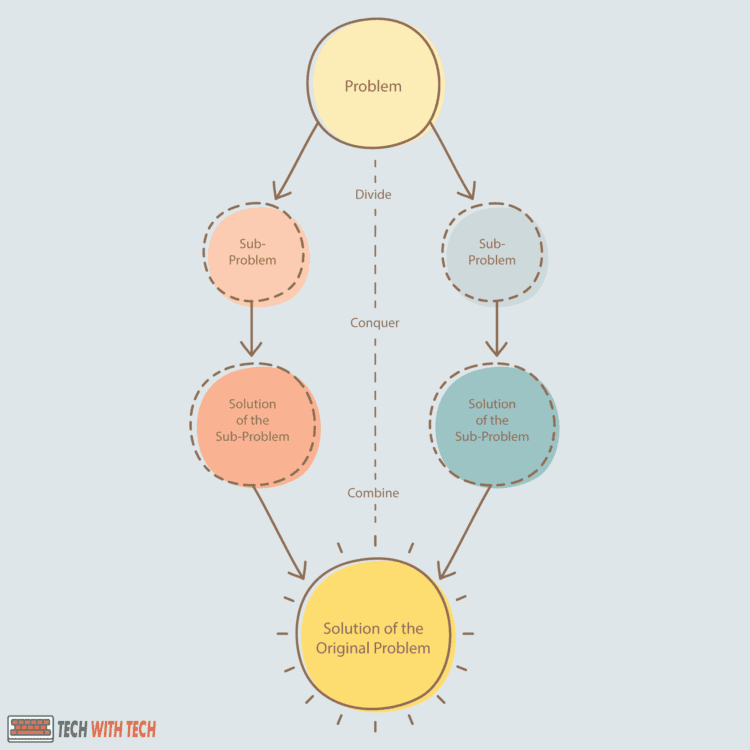Here’s how to use the divide and conquer strategy:
The divide and conquer strategy means breaking down a larger task, problem, or group into smaller, more manageable pieces.
Today, we use this strategy in various fields such as computer science, business, and politics.
With this centuries-old technique, lots of complex problems in many areas have already been solved.
So if you want to learn all about what the divide and conquer strategy and how to use it, then this article is for you.
Keep reading!
- Numbers like 69, 1337, 420 Etc? Online Number Meanings
- ICT Manager Meaning & Roles?
- Computerized Database: Meaning?
- Digital Information Technology: Meaning?
- Techno Functional: Meaning?
- ASCII: What Is ASCII & What Is ASCII Used For?
- SPOF: What Is a Single Point of Failure?

How Does the Divide and Conquer Strategy Help Us?
At some point in your life, you’ve probably heard someone offer advice by recommending a divide and conquer approach.
It’s a common phrase in today’s world, but it dates back centuries.
Julius Caesar, Machiavelli, Napoleon, King Louis XI of France, and the British Empire all used a divide and conquer strategy.
Even the United States government utilizes the divide and conquer method in its system of checks and balances.
Today, it’s also the foundation of a useful algorithm that helps solve the most complex engineering and computer problems, an effective marketing strategy, and a helpful sales tool.
In this article, you’ll learn what the divide and conquer technique is and how it gets applied to computer science, politics, business, and many other fields.
You’ll also see how it can help solve everyday problems, boost productivity, and improve efficiency.
What Does the Divide and Conquer Strategy Mean?

Now, what does divide and conquer mean?
To begin to understand this approach, you need to know the definition of the divide and conquer strategy.
Basically, the divide and conquer strategy means breaking down a larger problem, task, or population into smaller, more manageable pieces.
You then figure out solutions to those subproblems and combine them to solve your original problem.
Though initially conceived as a way to expand empires and control foreign governments, the divide and conquer strategy now applies to many areas of life.
What Is the History of the Divide and Conquer Strategy?
So, who originally said divide and conquer?
The divide and conquer strategy comes from the Latin phrase “divide et impera.”
It dates back to Philip II of Macedon, who used it to describe his method of rule from 359 to 336 BC when he reigned over the kingdom of Macedon.
The divide et impera translation means to divide and rule or divide and conquer.
In addition to Philip II of Macedon, many rulers throughout history have adopted this approach.
The divide and conquer origin also traces back to Julius Caesar, who made it most famous, and Napoleon, who frequently employed the tactic of separating his enemies.
What Is the Divide and Conquer Algorithm?
The divide and conquer algorithm frequently used in computer science is a paradigm founded on recursion.
It involves understanding a problem, separating it into subproblems, and combining the solutions to solve the larger problem.
You can use this tactic to solve several types of problems, including
- Sorting, including merge sort and quick sort
- Multiplying large numbers
- Syntactic analysis
- Internet searching with search engines, specifically binary searching
- Debugging
As with any approach, the divide and conquer algorithm has both advantages and disadvantages.
Pros of the Divide and Conquer Algorithm
On the plus side, this algorithm helps solve complex problems relatively quickly.
It has also led to the discovery of other useful algorithms like Karatsuba’s multiplication method, the Strassen algorithm, and rapid Fourier transforms.
Divide and conquer algorithms work well with processors because of their parallel structure.
They also allow for easy storing and accessing by memory caches.
Cons of the Divide and Conquer Algorithm
Unfortunately, this type of algorithm requires recursion, which takes up more space than other processes. Your recursion stacks may overflow, causing the solution to fail.
Choosing base cases may also pose problems.
Small, simple base cases typically lead to easier problems and solutions, while large base cases usually improve efficiency.
What Are the Steps of the Divide and Conquer Algorithm? (3 Steps)

To implement the divide and conquer algorithm effectively, you have to follow three steps.
Now, you may be wondering, what are the three parts of the divide and conquer approach?
Here’s your answer.
#1 Divide
When you come upon a large, complicated, or confusing problem, the first step of divide and conquer is to break it down into subproblems or subtasks.
You can create as many subproblems as you need until you arrive at ones that can be solved easily.
The key to this separation lies in maintaining the connection to the main problem while ensuring each subproblem stays smaller than the primary one.
You also must be careful not to allow any of your subproblems to overlap.
#2 Conquer
After you divide the problem, you have to work on solving your subproblems recursively.
You can only do this if you keep your subproblems smaller than your main problem.
If you encounter very small subtasks, you can choose those for your base cases.
To be successful in this step, ensure that you haven’t skipped any subproblems and that each one has a solution.
#3 Combine
To resolve your original problem, you must combine all of the solutions to the subproblems to generate an overall solution.
The more subproblems and recursive steps your problem has, the trickier this process will become.
However, no matter how conceptually complex your initial task, if you are using the divide and conquer algorithm, the steps are always the same: divide, conquer, and combine.
How Does Divide and Conquer Strategy Apply to Other Disciplines? (6 Disciplines)
Divide and conquer isn’t just an algorithm, though.
It applies to many other subjects, where it has both positive and negative consequences.
Here is some divide and conquer examples across disciplines.
#1 Marketing

Believe it or not, you can apply a divide and conquer approach to your marketing policy.
A divide and conquer marketing strategy centers around identifying your audience through segmentation, targeting, and positioning.
Segmentation
Segmentation involves breaking the marketplace down into subgroups based on a number of factors, including:
- Demographics
- Geography
- Socio-economics
- Behavioral qualities
Separating potential customers into smaller groups helps businesses determine where they should focus their marketing efforts.
Much like the divide and conquer algorithm, segmented groups should not overlap.
An example of segmentation is using a demographic, like age, to market a pop music festival.
The marketers for the festival could concentrate their strategy on radio stations or websites associated with young people instead of those connected with older populations.
Targeting
Marketers can also divide and conquer to target specific audiences, breaking larger groups down into target groups that match a product or service.
Within each target group, you will find further subgroups that narrow the population down even further.
For example, beauty companies target their makeup products toward women, with certain ones directed toward young women and others towards older women.
Positioning
With a positioning approach, marketers break their product down to show how it’s unique and more valuable to a target group in comparison to a competitor’s similar product.
By dividing the product into its attributes, marketers can better conquer their target group over their rivals.
#2 Business Management
A divide and conquer meaning in business includes both pros and cons that can either boost a company’s efficiency or hamper it with insecurity and distrust.
A positive divide and conquer business strategy involves assigning tasks to individual employees or groups of employees and empowering them to accomplish the tasks.
You can also think of it as a delegation.
With this kind of approach, you must be careful about which tasks you assign, making sure that they are not ones you have to do yourself.
Choose the employee wisely by matching skill sets to tasks.
When assigning a task, you should be as specific as possible about what you want and how the employee can achieve it.
Setting up checkpoints keeps the employee on track and allows you to monitor the employee’s progress.
You also want to motivate the designated employee to complete the task.
Taking back the job to do it yourself will only cause the employee to lose confidence and hinder their development.
As long as all goes well, your employee grows, and you save valuable time.
The Cons of Divide and Conquer Strategy in Business Management
On the other hand, when done wrong, a divide and conquer management strategy often encourages disharmony and a lack of collaboration among employees.
To implement this approach in the workplace, the leader or manager assigns different functions to individual employees or groups of employees.
But, instead of motivating to complete tasks, the supervisor fosters unhealthy competition between employees.
This method may also lead to insecurity among the subgroups since the leader maintains overall power over the groups and pits them against each other to get work done.
This strategy also prevents employees from growing beyond the manager.
Sometimes, this method backfires because the small groups shoot for goals that don’t serve the primary one.
It also leads to the need for more management control from the supervisor to keep the subgroups focused on the overall goal.
#3 Sales

A divide and conquer sales strategy can be extremely effective.
Similar to marketing, salespeople can use divide and conquer to target a receptive audience.
This approach helps you adjust your pitch to match your target audience, resulting in more sales.
Instead of calling every name on a general list, locating a particular segment of the population that may be most interested in the product you are selling can be much more effective.
You can base your audience on location, industry, age, or other factors.
You can also divide a sales force in order to reach more potential customers than you could otherwise.
Having multiple salespeople call the same customers isn’t as efficient as splitting up your team to reach a greater number of people.
This technique applies to face-to-face meetings, too. When salespeople head out on in-person sales calls, splitting them up among several clients makes much more sense than sending four people to one meeting.
#4 Political Theory
Divide and conquer politics has a long and complex history.
Sadly, it played a large role in empire building in the past, most frequently by the British Empire.
For example, the British utilized divide and conquer strategy politics in their colonization of India.
The divide and rule meaning in political theory relies on breaking up the existing power structures into smaller groups that are easier for the ruling country or class to control.
The imperial regime supports subgroups willing to cooperate with them and suppresses others.
In imperialism, colonizing nations also used divide and rule policy to suppress the lower classes by inciting discord between subgroups.
This approach prevents the lower classes from joining together and staging a revolution.
Niccolò Machiavelli is an example of a political theorist who said divide and conquers can lead to political success.
He advised doing so by fostering suspicion among the people and, if facing an enemy, weakening him by making him believe he must split up his forces.
#5 Modern Politics
One of the most serious divide and conquer problems lies in its use in modern politics.
Because the divide and rule strategy leads to the division of populations and creates discord between them, political leaders use this method to create an “us vs. them” mentality.
When they separate a population into subgroups based on race, religion, gender, and other differences, they make those subgroups easier to suppress and prevent them from unifying.
An example is the treatment of Jewish people under the Nazi regime of Adolf Hitler.
That said, divide and conquer does have positive uses in modern politics.
One example is the system of checks and balances present in the American government.
The three branches of government (legislative power, executive power, judicial power) keep each other balanced and prevent anyone from becoming too powerful.
Checks and balances also ensure that the government puts the citizens’ rights and the country’s needs first instead of promoting individual interests.
#6 Military
The divide and conquer military strategy dates back to the BC era, with some of the most celebrated military strategists taking advantage of it.
The divide and conquer definition, as it applies to military tactics, involves splitting up the opposing army by:
- Physically separating the enemy with maneuvers
- Making the opposing leader doubt his men
- Creating discord among the men, or between the men and their leader
Although the phrase likely came from Philip II of Macedon, Julius Caesar may be the most well-known practitioner of divide and conquer methods in military history.
He famously used these tactics during the Gallic Wars to overtake the much stronger Gaul army.
In the military treatise, The Art of War, Sun Tzu appears to support a divide and conquer approach when needed.
He advocates divide and conquer tactics throughout his writings as a way of breaking down the enemy.
For example, this divide and conquer quote from The Art of War about outsmarting and defeating your enemy: “If his forces are united, separate them. If sovereign and subject are in accord, put division between them.”
How Can We Use Divide and Conquer Strategy in Our Everyday Life? (3 Things)

Using the divide and conquer strategy in life can help us in several ways.
Here’s how a divide and conquer strategy works in problem solving, enhancing productivity, and streamlining tasks for better efficiency.
#1 Solve Problems
While divide and conquer problem solving works wonders in computer science, it serves the same purpose in real life.
In fact, this form of the divide and conquer strategy is probably the most familiar one to many people.
A parent or teacher has perhaps recommended a divide and conquer strategy to make an enormous workload more manageable.
To divide problem solving into smaller chunks makes the situation easier to control and understand.
Learning with a divide and conquer technique also helps us problem solve.
If you take a broad and overwhelming topic, break it down into smaller subtopics, and focus on learning those first, you’ll eventually come to a greater understanding of the general concept.
Divide and conquer also teaches us to avoid cramming as a way of learning.
A survey showed that 99% of students cram, but research shows it rarely works.
A divide and conquer strategy recommends committing a little time every day to a topic to remember it better.
#2 Boost Productivity
With productivity, it’s crucial to remember that it’s not about the volume of work you get done but how effective you are in completing the work.
To boost productivity with divide and conquer methods, you will have to break a problem or job down into smaller pieces.
Then, instead of trying to check off every task associated with that problem, focus on the priority tasks.
Following these divide and conquer guidelines will encourage you to work fruitfully by preventing you from feeling overwhelmed and stressed, two feelings that will only hurt your progress and productivity.
#3 Improve Efficiency
Here’s how divide and conquer strategy works to improve efficiency.
It shares many parallels with workplace delegation since your goal is to use your time wisely by figuring out how to accomplish tasks in a speedy but effective way.
To integrate divide and conquer, you can start by separating your tasks into subtasks.
By breaking your jobs down, you can see more clearly how to accomplish each one.
You can break them down into as many subtasks or steps as you need in order to visualize the way to completing them.
Although it seems like dividing your tasks in this way takes more time, this dedication will pay off in the end.
Once you have each task in front of you, it will also be simpler to jump from task to task, minimizing the amount of time it takes to figure out your next job and how you should go about achieving it.

